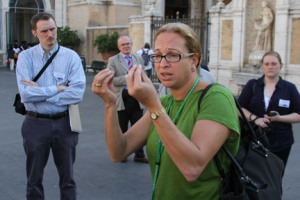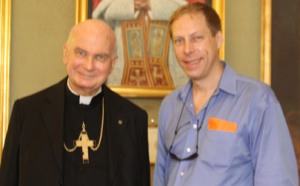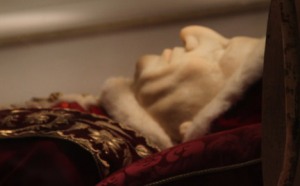SEPTEMBER 14, 2010 — I’ve been a Catholic journalist for more than 18 years. I’ve worked for an archdiocese, a weekly Catholic newspaper, a Catholic university, a religious order, and a few Catholic magazines—not to mention freelancing for a potpourri of national Catholic publications. So I sometimes feel like I’ve seen it all and heard it all. Then I came to Rome for a conference for journalists who cover the Catholic Church. The truth is, I’ve just scraped the surface. The universal Church is as diverse as its 1.1 billion adherents, yet we are one body in Christ.
This is my second post from Rome. I’ve just wrapped up a seminar—The Church Up Close: Covering Catholicism in the Age of Benedict XVI—at the Pontifical University of the Holy Cross (Santa Croce). Attending the seminar, organized by the university’s School of Church Communications, were 27 journalists from eight nations. Many of our speakers in the last half of the seminar asked that we keep their comments off the record, so this post doesn’t reflect the full scope of what we experienced, but it reflects the tenor of the class. Our speakers discussed everything from economic justice and the Church in Africa to Pope Pius XII and how the Church communicates in the digital age. Although I don’t expect to report on all of these issues any time soon, the speakers have helped build my base of knowledge on a huge variety of topic areas.
Stem Cells
The seminar’s fourth day kicked off with a subject I have reported on extensively—stem cell research. Father Bob Gahl, a Santa Croce professor, discussed what the Church really teaches about stem cells. Contrary to what the mainstream media preaches, the Church is not against science. It is not against progress, and it is not against stem cell research. The Church has always maintained that human life must be protected at every stage—from conception to natural death. It just so happens that one form of stem cell research destroys human life. Embryonic stem cell research (ESCR) requires the destruction of a human embryo. As a former embryo myself, I fully concur with the Church’s position.
There’s one aspect of such research that the Church hasn’t conclusively addressed. There are about 400,000 frozen embryos living in suspended animation. Some Catholics favor embryo adoption where these embryos would be implanted in a woman’s uterus (with her consent) in order that they may be brought to term. The others options are few: the frozen embryos will be destroyed in research or they will be allowed to die a natural death. The former is immoral. The latter is not. The debate is whether it’s moral to implant an embryo (that is already created) which will either die in research or, once its “shelf life” is over, it dies a natural death. Our presenter, Fr. Gahl, said he doesn’t expect the Vatican to make a pronouncement for at least 10 years. The last Church document on stem cell research was Dignitas Personae (The Dignity of a Person), issued in 2008 by the Congregation for the Doctrine of the Faith. Although the CDF hasn’t hinted that it will issue a new bioethics document any time soon, many expect one in the next few years.
We don’t expect embryo adoption to be included in the document.
Ultimately, Fr. Gahl said, the Church teaching on ESCR is based on the Biblical truth that human beings are created in the image and likeness of God and that Jesus Christ became flesh in his mother’s womb. Jesus, too, was once an embryo like all the rest of us. Science, Fr. Gahl said, has determined that within seconds of a sperm cell penetrating an egg, the cell “begins to act differently”—meaning that it is no longer two separate cells, but new creation, a human life. I often use the analogy that once a seed planted in the ground begins to sprout, it is alive. So too with a fertilized human egg.
Africa
Our Thursday afternoon session delved into the Catholic Church in Africa. What I expected to be a snoozer turned out to be one of the most interesting sessions of the entire seminar. Monsignor Fortunatus Nwachukwu, head of protocol at the Vatican’s Secretariat of State, delighted the entire group. The priest, who hails from Nigeria, began by discussing Vatican protocol, the ins and outs of the Holy Father’s foreign visits and his security, and the importance and reasons for the Holy See’s diplomatic outreach.
The most fascinating aspect of his talk, however, centered on the African church. While the Church in Africa is celebrating a century since the last major wave of Catholic evangelization, the continent has biblical roots. Moses had an Ethiopian wife. Jesus went to Egypt as a child. Simon of Cyrene was African, from modern-day Libya in Northern Africa. After the first-century destruction of Jerusalem (70 AD), many Christians moved to Africa. The Church declined until a wave of Portuguese evangelization around 1600, Monsignor Nwachukwu said. The slave trade, however, decimated the Christian population in Africa. Today, the Church in Africa is alive and vibrant, sending missionary priests to the United States, Canada and Western Europe.
Monsignor Nwachukwu noted that just as Arabic is a language that binds Islam together in prayer, Catholics must not forget that Latin has the same binding together effect for Catholics. He ended his talk by stressing that the Church cannot be allowed to fail in promoting reconciliation, justice and peace in every nation of the continent. This articulate 50-year-old priest will be one to watch as he rises through the ranks of the Vatican curia.
Benedict in the UK

Jack Valero
The Holy Father is scheduled to visit Glasgow, London and Birmingham from Sept. 16-19. He will meet Queen Elizabeth II and PM David Cameron. And he will beatify Cardinal John Henry Newman, the most distinguished Catholic convert of the 19th century. We had the distinct pleasure of hearing from Jack Valero, official spokesman for Newman’s beatification, on Thursday evening—a little more than a week before the actual event. This will be the first official state visit of a Roman pontiff to the United Kingdom in history. Technically, John Paul II’s 1982 trip to the UK was considered a pastoral visit. Pope Benedict was invited by then-Prime Minister Gordon Brown in early 2009.
Despite the incredibly secular culture in England, the state has been exceptionally accommodating for the papal visit, Valero said. The economic spin off from pilgrim spending will surely result in the state turning a profit. Another interesting tidbit Valero dropped was that Newman will be the first non-martyr Englishman to advance toward canonization in more than 400 years. Newman’s greatness, he said, was that he was willing to follow the truth wherever it led him.
Valero, himself, has made a big splash in the UK in the months leading up to the papal visit. He co-founded Catholic Voices, a team of 20 Catholic speakers able to articulate with conviction the Church’s positions on major contentious issues in the media. Since its launch in February 2010, the project has been reported in various magazines and newspapers. Its speakers have appeared in numerous public debates. They are professionally trained (thanks to Valero and his staff) to unflinchingly present the truths of the faith in a highly secularized culture. I told Valero that he should pursue a companion program for priests, bishops and seminarians. God willing, the tide will turn in the UK with folks like Valero leading the way after the papal visit!
Pope Pius XII
We were treated to a delightful lecture from the first Israeli-born priest in centuries when Fr. David Jaeger, OFM, spoke to us about the controversy over Pope Pius XII and the Jews. I’ve written about this subject a time or two, so Fr. Jaeger’s talk was informative and delightful. He’s a man who doesn’t need a microphone and has no problem holding his entire audience in the palm of his hand.
Among the facts that seem lost commentators on this subject: Eugenio Zolli, the chief rabbi of Rome converted to Catholicism after World War II ended because of Pope Pius XII’s commitment to saving Jews during the war. Jewish leaders (and everyone in the know) considered Pius a “righteous Jew” until 1965 when a historically inaccurate play called The Deputy was published. The play alleged that the pope did little or nothing to help Jews during the war. Eventually books like Hitler’s Pope followed, exacerbating the invented controversy. Then in 2005, the Yad Vashem holocaust museum in Jerusalem put up a plaque dissing Pope Pius. Sadly, the controversy has cast a cloud over the Pius’ cause for canonization.
Attack on Ratzinger
 Our final day in the classroom wrapped up on Saturday with an enthralling presentation by Andrea Tornielli and Paolo Rodari, authors of the newly released Italian-language book Attacco a Ratzinger: Accuse e scandali, profezie e complotti (Attack on Ratzinger: Accusations and Scandals, Prophecies and Plots).
Our final day in the classroom wrapped up on Saturday with an enthralling presentation by Andrea Tornielli and Paolo Rodari, authors of the newly released Italian-language book Attacco a Ratzinger: Accuse e scandali, profezie e complotti (Attack on Ratzinger: Accusations and Scandals, Prophecies and Plots).
Tornielli, one of the most respected Italian Vaticanisti, talked about attacks on the Pope that come from two distinct groups—from liberal progressives outside the Church that object to Catholic teaching on a wide range of subjects, and from those inside the Church who object to the Holy Father’s governance of the Church—including bishops who disagree with things like the Benedict’s motu proprio, the apostolic letter Summorum Pontificum announcing greater use of the Tridentine Mass, and his lifting of Bishop Richard Williamson’s excommunication despite the bishop’s denial of the full extent of the holocaust.
The Italian journalist, author and blogger argued that most Vatican critics have their mind made up about Benedict. They have a “frame” about him, and won’t accept anything that doesn’t fit in that frame.
Tornielli told us that the Roman curia structure hasn’t changed since Pope Paul VI’s 1967 reforms. All papal communication flows through the Secretariat of State, and the Holy Father doesn’t get information directly from the world’s bishops’ conferences or various dicasteries. The Vatican has, however, hired a Swedish company to monitor information about the Holy See on the internet, Tornielli said.
Both authors agreed that Pope Benedict is a very good communicator who addresses issues squarely. However, they also agreed that the Vatican really needs a communications strategy. It was clear from hearing from Tornielli, Fr. Federico Lombardi (director of the Holy See’s press office) and John Thavis (Rome bureau chief of Catholic News Service) that there’s tremendous lack of communication among the Vatican’s various departments, dicasteries, pontifical councils and the Pope’s personal staff. While it’s counterintuitive, Thavis told us earlier in the week that the disconnect in the Vatican works well. Tornielli was more ambivalent.
* * *
There’s so much more I could write about the seminar, but suffice it to say that Santa Croce’s School of Church Communications truly out did itself. This was its second seminar for journalists, and the next one is two years away. I expect it will fill up quickly.















